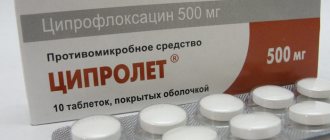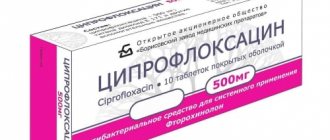Unfortunately, every day the number of patients with pneumonia and other ailments of the ENT organs is only increasing, and the disease cannot always be cured. That is why the question, “which is better: Tsiprolet or Amoxicillin?” very relevant.
Such negative statistics are due to the fact that the number of strains of viral and bacterial diseases is only increasing, and microorganisms that cause diseases are increasingly adapting to all kinds of antibiotics.
Ciprofloxacin
Antibiotic from the group of fluoroquinolones of the 2nd generation, widely used by medical practitioners. It is produced in many countries and has a large number of trade names. Tsiprolet, Tseprova, Tsiprobay, Tsiprosan, Tsiprolon, Ortsipol, Tsiprex, Tsiprodex are just a few of them, well known in our country.
The spectrum of action of ciprofloxacin is very wide; it destroys microorganisms by suppressing DNA gyrase, which is involved in the construction of the cell wall. The drug is slightly toxic to the cells of the human body, because they do not contain DNA gyrase.
This antibiotic effectively destroys a wide variety of microorganisms:
- Gram-negative aerobic bacteria (Escherichia coli, Shigella, Salmonella, Proteus, Yersinia)
- Other gram-negative bacteria (Pseudomonas, Neisseria, Campylobacter, Haemophilus influenzae)
- Some intracellular pathogens (legionella, chlamydia, listeria, brucella, corynebacterium, mycobacterium tuberculosis)
- Gram-positive aerobic bacteria (staphylococci, streptococci).
Ureaplasma, Bacteroides fragilis, Clostridia, Pseudomonas nocardia, as well as Treponema pallidum, which causes syphilis, are resistant to this drug.
Bacterial resistance to fluoroquinolones develops extremely rarely. This is due to the fact that after an adequate course of antibiotics of this group there are no persistent bacteria (able to survive and begin to reproduce), and also because the cells of microorganisms do not have enzymes that inactivate this antibiotic.
Pharmacokinetics
Ciprofloxacin is rapidly and almost completely absorbed from the intestine. Eating may slow down absorption, but does not affect the final plasma concentration of the drug (bioavailability is approximately 50-85%). The drug distributes well throughout the body, with the exception of fat-rich tissues (for example, nervous tissue).
This antibiotic is most widely used in urology and gynecology, because high levels of it in urine were noted when administered intravenously.
Release forms
For oral administration, the drug is available in film-coated tablets with a dosage of 250 mg, in a contour package of 10 pieces.
For the treatment of conjunctivitis and otitis, ciprofloxacin is available in the form of ear and eye drops (in a bottle of 5 ml of 0.30% solution).
For intravenous drip infusions, bottles with an infusion solution with a dosage of 2 mg/ml are used (100 ml of solution per bottle, 5-10 bottles per package).
Reception mode
Compliance (the patient's willingness to follow the doctor's recommendations) when prescribing ciprofloxacin is quite high. The frequency of dosing of the drug in tablets is convenient for patients (2 times a day), which is possible due to a longer half-life compared to penicillins. and the course of application is not very long (5-10 days). When used intravenously, it is sufficient to use the drug once a day.
Indications
Ciprofloxacin is used to treat inflammatory and infectious diseases. When prescribing, the sensitivity to the drug of those bacteria that caused the disease is taken into account.
Contraindications
The drug is not approved for use in children, pregnant and lactating women, as well as in case of individual intolerance.
In what cases is an antibiotic necessary?
Antibiotics mean substances of various origins that have a detrimental effect on the growth of various microorganisms that cause diseases in humans. Consequently, the use of these drugs for prostatitis in acute or chronic form will be advisable only in cases where the disease is caused by bacteria.
However, prostatitis can be caused by a number of factors:
- calculous form - with stones;
- chronic form - most often due to a sedentary lifestyle or sexual excesses;
- fungal form - rare, caused by various fungi;
- stagnant form - occurs due to stagnation of blood or prostate secretion.
The forms of prostatitis listed above are abacterial, so prescribing antibacterial drugs will be unnecessary. In the case of chronic prostatitis, antibiotics are also most often not needed - it is enough to adjust your lifestyle and take some symptomatic medications to put the disease into remission.
Antibiotic therapy is advisable only in cases of acute bacterial prostatitis caused by various pathogenic microflora. Most often we are talking about sexually transmitted infections - syphilis, chlamydia and trichomonas, and so on. Also, drugs in this group can be prescribed for calculous prostatitis as an auxiliary and prophylactic agent.
To determine the type of pathogen, the doctor will refer the man for laboratory tests:
- blood and urine for general analysis;
- blood PSA to exclude oncology;
- prostate secretion - to identify the pathogen;
- scraping from the urethra - to identify STIs;
- three-glass urine sample.
Only after the pathogen is detected can the best and most effective antibiotic be selected. But knowing this information, it is too early to start treatment. The man must undergo an examination of the liver, kidneys, heart and other organs that will increase the load during the course of therapy. Knowing the characteristics of the patient’s body and the nature of prostatitis, the doctor will be able to correctly select an antibacterial agent and minimize the risk of complications.
Amoxicillin
the broad-spectrum antibacterial drugs , but from a different group of penicillins. Like other betalactam antibiotics, it has a weak point - amoxicillin can be destroyed by betalactamase, which is produced by many bacteria. Therefore, doctors prefer to prescribe combination drugs consisting of amoxicillin and a betalactamase inhibitor (clavulonic acid).
Like ciprofloxacin, this antibiotic has a bactericidal effect on microorganisms by inhibiting the enzyme (transpeptidase), which is involved in the production of a component of the microbial cell wall (peptidoglycan). This leads to the destruction of bacteria.
The spectrum of action of penicillins is less than that of fluoroquinolones.
Amoxicillin is effective against:
- Aerobic gram-positive bacteria (staphylococci, streptococci)
- Aerobic gram-negative bacteria (Shigella, Salmonella, Neisseria, Klebsiella, Escherichia coli).
Pharmacokinetics
Bioavailability is high (93%), absorbed very quickly in the intestines. The effect of the drug begins within 15-30 minutes after ingestion. Eating does not affect its absorption and content in tissues. Amoxicillin is distributed to almost all tissues of the body, but at the same time the blood-brain barrier and the placenta are poorly susceptible to it. The half-life is quite short - 1.5 - 2 hours.
Release forms
Only forms for oral administration are provided:
- Tablets of 150, 250, 500 and 1000 mg, soluble form, 20 pieces per pack.
- Capsules or tablets of 250 and 500 mg in contour packaging of 16 pieces.
- Granules in a 100 ml bottle for the preparation of a suspension, dosage 250 mg/5 ml - a special release form for children.
- Amoxicillin is not available for intramuscular and intravenous administration.
Reception mode
The effect of the drug lasts about 8 hours, which requires increasing the frequency of administration to 3 times a day. This reduces its compliance.
Indications
The same as ciprofloxacin - treatment of inflammatory and infectious diseases, taking into account the sensitivity of pathogenic flora to it.
Contraindications
Individual intolerance, lactation, allergic diseases, infectious mononucleosis, lymphocytic leukemia, liver failure.
Pregnant women may use it with caution.
Comparison of two drugs
Benefits of Ciprofloxacin:
- Due to the wider spectrum of action, the risk of developing superinfection caused by the growth of flora insensitive to the antibiotic is minimized (which cannot be said about amoxicillin monotherapy).
- Bacteria develop resistance to fluoroquinolone antibiotics much more slowly than to penicillins.
- Due to its wider spectrum of action and the lack of bacterial resistance to the drug, ciprofloxacin can be prescribed for emergency indications, without assessing the sensitivity of the microflora to it.
- It is possible to use the drug intravenously, which is simply necessary for severe infectious lesions, when it is necessary to quickly achieve maximum concentrations of the antibiotic in the body.
- The half-life of ciprofloxacin is two to three times longer than that of amoxicillin, which increases its compliance.
- This is a fairly inexpensive antibiotic.
Amoxicillin benefits:
- Can be used in pregnant women and children due to low toxicity.
- The convenient form of release in the form of granules for preparing a suspension is indispensable for children.
- Unlike ciprofloxacin, it is effective against Treponema pallidum, which causes syphilis, as well as against ureaplasma.
- It is also not an expensive drug.










